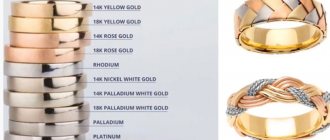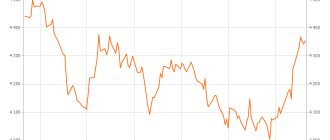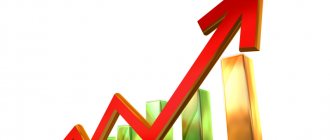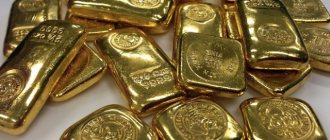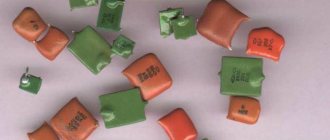"First pasta, then toilet paper - and now gold." The online version of the weekly Der Spiegel reports on the rush demand for the precious metal that has arisen in Germany. On the website of the Degussa company, the publication said, one could only admire gold coins and bars, even kilogram ones, on one of the last days: everything was sold out.
Excessive demand from retail buyers
Long queues formed this week in Freiburg, Leipzig and Bremen outside branches of another major precious metals retailer, Philoro. “Demand is growing at about the same rate as the coronavirus is spreading,” company chief executive Christian Brenner told reporters. He even had to transfer his retail outlets to work in two shifts.
The line for gold of about 80 people was observed in Frankfurt am Main by a correspondent for the newspaper Süddeutsche Zeitung. “I’m afraid of what will happen,” one of the buyers explained his motives to the journalist, and those around him nodded in agreement. A woman nearby added: “What if the gold disappears soon!” Those present do not pay attention to the fact that sellers have raised prices for their goods, the publication noted.
In Germany, gold is traditionally seen as a “safe haven”, a protective investment that does not lose and even increases its value in difficult times. And now they have arrived, and the rush of demand from small German retail buyers looks like a completely typical reaction. But large international institutional investors are not acting in a textbook way during the current pandemic: they are selling gold, not buying.
The collapse in oil prices led to a sell-off in gold and silver
True, the sale began only in March, along with an accelerating collapse in stock, commodity and currency exchanges around the world. Throughout last year, gold prices, on the contrary, grew, and significantly. If at the beginning of 2021 a troy ounce cost just under $1,300, then by the end of December it was already over $1,500.
After this, in January-February of this year, the rise in price in the context of a growing epidemic and a falling global economy accelerated even more, which was fully consistent with the traditional idea of the role of gold as an anti-crisis asset. As a result, they began to pay $1,700 for a troy ounce at the beginning of March.
March 9, 2021 will go down in history as the beginning of the “oil war” between the Russian Federation and Saudi Arabia
However, on March 9, when the world commodity market reacted with a 30% collapse in oil prices to the price war between Russia and Saudi Arabia, the precious metals market also went down sharply. A week and a half later, gold had fallen to about $1,470 and a troy ounce of silver had plummeted from $17.50 to less than $12.00.
Of course, against the backdrop of what is happening now with oil and many stocks, losses in gold within 15 percent do not seem very significant. So far, it has “only” lost the exchange rate growth for the current year, returning to the quotes of mid-December. But a change in trend and atypical market behavior are striking: the world economy is rushing towards a deep recession, and international investors are hastily leaving the “safe haven”.
An anti-crisis asset has to be released onto the market
The title of the article in the Süddeutsche Zeitung is very indicative: “Crisis metal in crisis.” The newspaper explains the atypical behavior of professional investors, in particular, by the fact that many of them, due to the collapse on the stock exchanges, have to urgently repay loans with which they bought shares and other assets (for example, oil futures), and therefore they throw everything onto the market. which can be quickly converted into real money, including gold.
Another explanation from the newspaper: Managers of investment funds that have precious metals in their portfolios are usually required to adhere to certain restrictions, say, holding no more than 5 percent of their investments in gold. But now, due to a sharp decline in the price of securities, this share suddenly turned out to be much higher, and portfolio managers are forced to sell precious metals at all costs in order to eliminate the imbalance that has arisen.
India is one of the world's most important gold jewelry markets.
In addition, demand in the most important market for gold jewelry - in Asia, primarily in China and India - has sharply contracted. “Many people there now have no time to deal with gold chains,” recalls the Süddeutsche Zeitung. The frantic buying of gold coins and bars by German small investors is unlikely to fundamentally change the situation.
Russia's gold and foreign exchange reserves: what will happen when they are needed?
The dynamics of quotations on the world gold market is of no small importance for Russia, especially in a situation where there has been a collapse in prices for its main export commodity - oil - and there is a devaluation of the national currency - the ruble. In the context of the now inevitable severe economic crisis, the Russian government will certainly have to use accumulated reserves to fulfill budget obligations or emergency rescue of various businesses.
And a fifth of Russia's gold and foreign exchange reserves are invested in the precious metal. According to the Central Bank of the Russian Federation, the country's international reserves amounted to 570.38 billion US dollars as of March 1, 2021, with monetary gold accounting for 119.75 billion.
Moscow, Central Bank of the Russian Federation, January 2011: Vladimir Putin with a gold bar
What if the bullion stored in Moscow has to be urgently converted into currency - for example, to purchase necessary imports? Now, when more and more states are forced to announce multi-billion dollar programs to support the economy, such large buyers as the central banks of other countries are unlikely to simply purchase gold in reserve. Even in a situation of falling prices.
Russia has been aggressively buying gold to replenish its reserves for a decade and a half, and German media have repeatedly written about this strategy, weighing its pros and cons.
Thus, in the summer of 2015, after a period of price declines from $1,900 to $1,100, the newspaper Die Welt wrote that Putin had driven Russia into a trap of gold reserves, and experts interviewed by DW argued that it was too early to talk about a strategic mistake. At the same time, in the summer of 2019, an author for the German television channel n-tv emphasized that Putin was right in betting on gold, and even proclaimed the Russian president “Person of the Week.” Now, perhaps, the arguments voiced during the discussion will be tested in practice.
See also:
How the world is fighting coronavirus
The coronavirus pandemic has affected more than 188 countries
The total number of people infected with coronavirus in the world by June 12, according to Johns Hopkins University, was about 7.5 million people, the epidemic spread to at least 188 countries and territories. About 3.5 million people have recovered, over 420 thousand have died from the consequences of coronavirus infection.
How the world is fighting coronavirus
Events are being canceled around the world
Due to the spread of the SARS-CoV-2 coronavirus, public events, primarily sporting events, are being canceled around the world. The Olympic Games in Tokyo were postponed a year later, in Germany the world's largest tourism fair ITB in Berlin, the Leipzig Book Fair, the Craft Fair in Munich, as well as the annual beer festival Oktoberfest (pictured) were cancelled.
How the world is fighting coronavirus
Current and updated forecast for gold, oil, dollar, ruble, euro and pound for 2021-2022
It’s the beginning of March 2021 and I decided to update my forecast for a number of important trading instruments, since my point of view has changed for some of them.
Gold forecast for 2021-2022
For gold, my vision remains the same - in 2021 I wrote that it would return to $1400. From $2060 it has already corrected to $1710 and this trend will continue in the future. Let's go for a walk and that's enough. Moreover, I would not be surprised if in the next 3 years gold reaches $1000 dollars per troy ounce.
gold forecast 2021-2022Oil forecast 2021-2022
Oil will continue its victorious ascent. At the moment it is trading at $64 per barrel (Brent) and I am now expecting a correction to $58-59, but this is noise. A year ago, I recommended buying it at $30 and hedging interested parties against the risks of rising prices for black gold. At the same time, the price target indicated $43 and $57 per barrel. These levels have already been reached. My forecast for oil for the next year or two: the price will easily overcome $100 and go higher, updating its highs. In my humble opinion, it will cost ~$160 dollars per barrel.
oil forecast for 2021-2022Forecast for dollar, ruble, euro and pound for 2021-2022
In relation to the dollar, I have seriously revised my views and it is in the spring of 2021 that I will see either confirmation of my forecasts or their irrelevance. Biden, in my opinion, will be no better than Trump. And if Trump made a lot of noise in America itself, then with Biden at the head of the United States, he will again begin to get involved in armed conflicts, especially where there are resources, in particular oil. At the same time, the dollar will strengthen against all currencies!
My updated forecast is as follows: the ruble will go above 100 (currently 73-74), EURUSD will test parity with the dollar 1:1 (currently 1.2), the pound from 1.4 will move to 1.1-1.2, USDJPY from the current 1.07 will most likely go to 1.26-1.3 , other currencies are similar.
dollar to ruble exchange rate forecast for 2021-2022
I’ll say right away that my old forecast for the euro against the ruble (it will go above 160) has lost its relevance. In the next year or two, I expect the euro to rate slightly higher than the dollar, and then they will become equal.
Although I have previously argued with those who advocated for the US dollar, my recommendation now to anyone who is wondering what to do with their savings in such a situation is to buy US dollars! There is no politics here, this is not a betrayal of the Motherland (although I would not be surprised if in Belarus (and then in Russia) the purchase of foreign currency is equated with high treason and sentenced to death. But the Creator will not allow this, since this is an obvious regression.
As an alternative investment for myself, I chose one of the undervalued cryptocurrencies, but I do not recommend investing in shares of Russian companies, nor do I recommend freezing your funds in a Russian fund.
Thank you for reading to the end. Contact me and current news in the telegram channel “Conscious Investments”.
Europe is trying to protect itself from coronavirus
Fearing the rapid spread of coronavirus, almost all EU countries have closed their national borders. Classes in educational institutions were initially completely canceled, and later restored to a very limited extent. In the photo: a medical worker on the Austrian-Italian border measures the temperature of a car driver. Elevated temperature is a reason for a ban on entry into the country.
How the world is fighting coronavirus
Italy, Spain, UK
Italy and Spain were the first to be hit hardest by the coronavirus in Europe. In Italy, quarantine throughout the country was introduced on March 9. The streets and squares of Italian cities were empty, and the army was involved in maintaining public order (see photo). By the end of May, the maximum number of deaths from SARS-CoV-2 in Europe was recorded in the UK.
How the world is fighting coronavirus
Germany: gradual easing of quarantine measures
Until February 25, only 16 cases of coronavirus infection were registered in Germany. But then the number began to rise sharply. By June 12, the number of infected people exceeded 186 thousand people. The most infections are in the states of Bavaria, North Rhine-Westphalia and Baden-Württemberg. About 8.7 thousand people died. On April 27, the country began a gradual easing of quarantine measures.
How the world is fighting coronavirus
Gold rate forecast for 2021
The price of gold is the result of many coincidences. This figure is influenced by a bunch of factors, such as the strength of a particular currency, prices for other raw materials, and the health of the economies of the largest countries.
If everything goes smoothly, then the price of gold will obviously behave as it did in the past two years. From December 2015 to August 2021, the price of gold gradually rose, followed by a gradual decline until December 2021.
From December 2021 to September 2021, the graph showed the same. Ascent and then descent from September to December 2021.
In the first half of 2021, we should expect the same dynamics of rising gold prices. This will probably be followed by a decline starting in August or September.
Excessive demand for disinfectants
Due to the coronavirus outbreak in Germany, there has been a rush of demand for disinfectants and liquid soap. At first, the shelves in supermarkets and household chemical stores were empty, previously filled with all kinds of bottles and tubes of antiseptics. By May, supplies were restored. Some stores only have notices asking people not to buy goods to stock up at home.
How the world is fighting coronavirus
Analysts predicted the next stage of growth in gold prices
MOSCOW, March 31 — PRIME. The price of gold on the market last year reached a historical record amid the pandemic and the subsequent economic crisis, but in the first three months of 2021 it has already lost more than 10% and is stuck in the neutral zone of 1670-1765 dollars per ounce. Such a correction was expected by the analysts surveyed by RIA Novosti, and, in their opinion, a new turn to rising prices in the market is possible soon.
Gold falls in price by almost two percent and is trading below $1,700
“By the end of the year, prices may recover to $1,850 per ounce if there is no significant tightening of monetary policy and retail demand for the metal continues to recover. And, of course, the level of inflation in the largest economies will be of great importance,” said Otkritie Broker commodity markets analyst Oksana Lukicheva.
“The current combination of factors is not conducive to gold growth, so in the medium term I do not expect a return to the level of $2,000 per ounce. The market does not yet have the potential to even overcome the resistance level of $1,750,” she added.
The forecast of the Ural Bank for Reconstruction and Development (UBRD) is much more optimistic: according to the head of the department of operations with precious metals, Evgeny Afanasyev, an increase in gold to the psychological level of $2,000 is possible in the second half of this year. “The price recovery will be driven by inflation and a weakening US dollar, which is inversely correlated with gold amid President Joe Biden's $1.9 trillion economic relief package,” he said.
“The risk of an upward breakout is quite high,” agrees Ole Hansen, head of commodity strategy at Saxo Bank. “Renewed momentum above $1,765 an ounce will attract fresh demand from speculators who have until recently been trimming their long futures positions,” he believes.
FORECAST NEUTRAL
Algo Capital senior risk manager Vitaly Manzhos, on the contrary, sees the likelihood of the precious metal returning to this level only in 2022-2023. “The price chart shows that some time after the acute phase of the previous two ten-year cyclical crises, the price of gold increased significantly. A similar movement may emerge at the turn of 2021-2022,” the expert said.
On the other hand, analysts see no reason for a further fall in prices for the yellow metal. According to Manjos, from a technical point of view, gold prices have already retreated quite far from their historical high and have met quite expected support around $1,680. “The correction in futures looks quite large, but not excessive. They are unlikely to fall below $1,600 per ounce in the coming weeks and months,” he is confident.
“As a speculative asset, gold often defies understandable logic. For now, we can only state that its popularity in the middle of last year, fueled by a combination of fears for the stability of the economy and excess liquidity in the markets, is in no hurry to return. Therefore, the forecast for the next quarter is neutral,” agrees Vladimir Bragin, director for analysis of financial markets and macroeconomics at Alfa Capital Management Company.
Coronavirus has reached Russia
The number of people infected with coronavirus in Russia by June 12 exceeded 510 thousand people. The largest number of cases was registered in Moscow, the Moscow region, St. Petersburg and the Nizhny Novgorod region. In Moscow and Moscow Region, a universal access control regime has been in effect since April 15. They also plan to introduce a platform for issuing such digital passes in another 21 regions of Russia.
How the world is fighting coronavirus
Israel: strict quarantine brought results
In Israel, by June 12, more than 18 thousand people were diagnosed with coronavirus. The country has taken strict measures to combat the spread of coronavirus, including complete quarantine and a ban on foreigners entering the country. On April 19, a gradual easing of quarantine measures began, some non-food stores opened and public transport resumed.
How the world is fighting coronavirus
Gold Market Outlook 2021 – GFMS
2018 can well be considered an illustration of the phrase “a lot can change in a year.” The fact is that the unstable political and economic environment throughout the year led to the volatility index (VIX) jumping to its highest level in 4 years in February, rebounding from its lowest level recorded in 2021. However, despite the third year of continuous growth, the gold rate rose only 0.9% year-on-year (which is similar to the situation in 2021, when the increase was only 0.5%). For the second year in a row, the dynamics of the yellow metal exchange rate is, so to speak, anomalous, since before the rate increased or decreased by 5% or double digits. The gold market experienced a moderate decline in physical demand last year, driven by falling demand for both jewelry and retail investment products that failed to offset increased production. Therefore, the net balance was +485 tons, which is the highest level since 2003.
Although last year started on a positive note, with positive economic forecasts from the World Bank, most countries (except the US) ended the year with their growth rates declining (China is a key example, as the country's GDP fell to its lowest level in 28 years). Meanwhile, rising U.S. inflation, which pushed Treasury yields to their highest levels since late 2013, prompted the Fed to make four interest rate hikes during the year, with the dollar index up 4% for the year. While the news weighed on gold, the rise in the dollar index hurt emerging market currencies, turning investors' attention away from risky assets. The situation was aggravated by increased protectionism, which was expressed in the introduction of US sanctions against several developing countries (for example, Turkey, which is now experiencing an economic crisis, suffered from them); At the same time, the escalating trade war between the US and China has hurt exports worldwide. By the end of the year, the economic growth forecast was lowered as political infighting erupted in Europe and South America, increasing investors' desire to buy gold as a means of diversification, and central banks (especially in developing countries) increased their gold reserves to reduce dependence on the US currencies.
Gold supply in 2021
— Production rose 2% in 2021 to 3,332 tonnes overall, driven by strong production growth in Indonesia and the US.
— Total cash production costs rose 5% to $696 per ounce, while total costs rose 4% to $897 per ounce.
— Global scrap supplies fell 3% in 2021 to 1,178 tonnes, a three-year low, as weak exchange rate performance curbed interest in gold recycling.
So, global production increased by 2% in 2021, amounting to 3,332 tons. This was due in part to higher grade ore and throughput at Indonesia's Grasberg mine, as well as year-long operations at Canada's Rainy River and Brucejack mines. Significant increases in production were also recorded at the Malian Fekola mine and the Congolese Kibali mine following intensive ramp-up. At the same time, a 16-ton decline in production was a result of low-quality ore at the Veladero and Pejasquito mines, as well as low productivity at Lagunas Norte. China remains the largest gold producer, but efforts by the country's authorities to reduce the environmental impact of gold mining have led to a 6% drop in volumes in 2021. Regionally, gold production in North America increased by 7% or 35 tonnes compared to 2021, while that of Africa fell by 11% or 17 tonnes, the largest annual decline since 2012 of the year.
Last year, production costs rose again when looking at total cash costs, but this time by 5% to an average of $696 per ounce, while total costs increased by 4% to $897 per ounce. Increased fuel costs and poor ore quality were the main reasons for the increase in costs, which were partially offset by significant currency depreciations in Australia, Argentina and Indonesia, as well as other producing countries of the yellow metal. South Africa was hit hardest by rising production costs as power outages and lower output pushed costs up 10% to $1,107 an ounce and cash costs up 12% to $1,335 an ounce.
The global hedge book grew 4% year-on-year to 219 tonnes. A stronger dollar for much of the year pushed domestic gold prices in Australia and Canada to record highs, so companies took advantage of forward contracts, especially in the fourth quarter of 2021. The top three hedgers included , Newcrest and Westgold, including a total of 29 tons in the hedge book, while the Russians dehedged their positions and sold 15 tons of options, and Petropavlovsk delivered 6 tons under forward contracts. GFMS estimates that hedging activity will continue to increase during the first quarter of 2021 as favorable pricing conditions exist at the moment.
Global scrap supplies fell for the second year in a row in 2018, down 3% to 1,178 tonnes, as the generally stable US dollar price of gold did not make recycling attractive. Asian markets accounted for almost 55% of scrap supply, down 4% year-on-year, despite strong growth in India.
Scrap supplies from Japan fell sharply after the government cracked down on gold smuggling; as a result, processing fell by almost a third. Elsewhere, improving economic conditions have helped lower recycling volumes (e.g. in North America), while in Europe scrap shipments rose 2% in 2021, mainly as a result of a rise in Turkey following the collapse of the lira, which led to growth domestic gold prices, triggering profit-taking.
Demand in 2021
— Jewelry production fell 4% year-on-year to 2,129 tonnes, with strong sales growth in North America offset by declines in Europe and Asia.
— The volume of gold used in industrial production rose slightly in 2021, rising 3% to a four-year high of 391 tonnes, helped by rising demand from the electronics industry, which rose 4% thanks to strong demand in the semiconductor market.
— Aggregate physical demand was little changed in 2021, contracting by less than 1%, with increases from government demand coupled with growth in industrial demand offset by declines in jewelry production and retail investment.
— Net gold purchases by governments reached the second highest level this century, reaching 536 tonnes in 2021, amid continued acquisitions by traditional buyers and the entry of “new” emerging countries into the market.
Total physical gold demand fell less than 1% in 2018 after double-digit growth the previous year. Jewelry production contracted, down 4% year-on-year as growth in North America was offset by declines in Europe and the Middle East, with fall in Asia down 5% year-on-year as a double-digit decline in Indian production lowered the aggregate result. Meanwhile, retail investment gold demand fell 11% last year, driven by a 19% year-on-year decline in bullion production, while public sector demand rose to 536 in the final quarter of the year. tons, an increase of 47%, reaching the highest level since 2012. At the same time, industrial demand entered its second year of growth, up 3% over 2017, driven by continued growth in the electronics sector, which reached a four-year high of 288 tonnes.
Global jewelry production fell 4% in 2018 to approximately 2,129 tons. Weakening performance across Europe, driven by political woes and worsening trade conditions, saw jewelery demand fall 6% year-on-year to a record low, also driven by a sharp decline in Turkey following the collapse of the local currency and a fall in Italy. Offsetting those losses was a strong result from North American manufacturing, which jumped 8% as the dollar strengthened and the economy improved, with U.S. demand up 10% from a year earlier.
Meanwhile, jewelry demand in Asia, which generally accounts for more than 80% of the global total, fell 5% last year compared with 2021 figures. Jewelry production in China began to grow for the first time since 2013, rising 2% to 688 tons, mainly due to demand for pure gold products. Jewelry demand in India fell 12% year-on-year to an estimated 632 tonnes; Thus, the country lags behind China, although sharp growth was recorded in 2021. Demand in the Middle East was weak as some markets in the region were heavily impacted by the UAE's goods and services tax.
The volume of gold used in industry rose 3% in 2018 to 391 tonnes, its second annual increase in a row, driven primarily by continued growth in demand in the electronics sector, which hit a four-year high of 288 tonnes last year year. However, demand has weakened in the final months of 2021 as a result of the trade conflict between the US and China and the resulting supply chain issues. Demand for gold used in other industrial and decorative applications rose 1%, while demand from the dental industry continued its long-term downward trend, but this time fell 2%.
Government net purchases continued to rise in 2018, continuing a 9-year upward trend, with government activity up 46% or 274 tonnes to 536 tonnes, the second highest this century. While Russia has been the largest buyer of gold for the 7th year, purchasing 274 tons of gold in 2021, second place was shared between Kazakhstan and Turkey, which each bought 51 tons of the yellow metal. While Kazakhstan and other CIS countries remained key players in this market, increasing their reserves last year, the emergence of demand from other developing countries (which previously did not buy much gold, such as India) also contributed to the overall increase. Along with these purchases (and aggregate sales figures were weak), another key story last year was the continuation of the trend of gold repatriation, with countries such as Hungary and Turkey leaning towards keeping all gold reserves at home. Overall, identifiable investment - which includes investments in physical bars and coins as well as exchange-traded products - fell 19% to 982 tonnes, the lowest level since 2007, while demand for coins increased at 14% did not compensate for the weakening demand for physical bullion. Meanwhile, the inflow of investment into exchange-traded products was 67% lower than in 2021, amounting to 59 tons last year.
Forecast for the gold rate and the market as a whole
On February 19 this year, gold rose $10 an ounce to $1,341 an ounce, its highest level since April 2021 (although prices have since eased, falling below $1,300 an ounce). The big move was driven by the return of positive investor sentiment towards the yellow metal, with inflows into exchange-traded funds at the highest since April 2013 (data to 30 January), while net positions under management jumped 71t (at time of writing) of this report), driven by gains in long positions (following a short covering rally that sent them to their lowest level since June 2021 (January data)). According to GFMS forecasts, supply will again exceed physical demand this year, so the market will record a surplus of 250 tons. While supply is expected to contract slightly (amid lower production volumes), physical demand growth will increase by 6%, driven by a strong increase in retail investment, while jewelry and industrial demand will also pick up. Given recent weakness in US economic demand, unemployment and inflation indicators (limiting the US dollar's upward momentum), the Fed announced in March that it would leave interest rates unchanged this year (after previously planning to raise rates two more times). While the news is generally positive for gold, additional upside could come from a possible correction in the stock market as the health of emerging and developed economies comes into question, especially in light of the ongoing trade war between the US and China.
Iran: real numbers may be much worse than official ones
By June 12, Iran had registered more than 180 thousand cases and more than 8.5 thousand deaths. It is possible, however, that in reality the numbers could be much higher. In an attempt to prevent the spread of the virus, Iranian authorities have ordered the city streets to be generously flooded with disinfectants (pictured).
How the world is fighting coronavirus
How much do they give for gold today at a pawnshop?
I look at prices in pawn shops in major cities. The larger the city, the more competition there is among pawnshops. The more competition there is, the higher the gold valuation we are offered. Therefore, prices in a small town can be much lower.
Today, pawn shops advertise a tariff of 1,500 rubles per gram of 585 purity . This beautiful figure appeared quite recently. In fact, pawnshops accept gold from 1400 to 1450 rubles per gram.
At the beginning of January, pawnshop display boards were decorated with the figure 1,450 rubles per gram of 585 purity , when in fact gold was accepted at 1,380-1,400 rubles per gram.
China: the coronavirus epidemic has subsided
Meanwhile, in China, where the SARS-CoV-2 outbreak began at the end of 2021, there are no new cases of infection. Most of the hospitals built for coronavirus patients in Wuhan are closed. The photo shows doctors from one of the temporary hospitals in Wuhan at its closing ceremony. In total, about 84 thousand people fell ill with coronavirus infection in China, and about 4,600 died.
How the world is fighting coronavirus
Gold Market March 2021 – Perth Mint Blog
The yellow metal fell 3% in March, falling below $1,700 an ounce. The correction was due to many factors. Investor sentiment is currently not favorable for the precious metal. The volatility of its quotes will not go away, but the correction should soon end, since the decrease in price has aroused interest from those who could not previously purchase the precious metal due to its high cost.
In the first three months of 2021, gold fell by 11% and silver by 9%. The decline in prices for the yellow metal was the third-largest quarterly decline. The precious metal has not had such a bad start to the year for two decades.
Multiple factors have contributed to the yellow metal's US dollar price decline by 20% from its August 2021 all-time high. We are talking, first of all, about the rally of the US currency, the index of which rose by almost 3% in March, and it is worth mentioning the rise in real yields on US Treasury bonds. The increase in prices for cryptocurrencies also undermined the demand for gold: Bitcoin began to trade at around $60,000. The continued rise in stock markets has reduced demand for safe haven assets, although inflation expectations are rising. The S&P 500 index exceeded 4 thousand points by the beginning of April, and optimistic sentiment prevails among traders due to economic growth and soft fiscal and monetary policies.
This report examines these factors, the relationship of gold to other commodity assets, and the demand for exchange-traded products, futures, bars and coins. All this data will help you understand what state the market is in and what to expect from it. At the end of the report, information is provided on investor sentiment in the gold market and the reasons for ending the rate correction in the near future, given the excess of $1,700 per ounce in early April.
Bond yields and inflation
An increase in Treasury bond yields is one of the factors that influenced the decline in quotations of the yellow metal. In the table you can see the change in nominal bond yields and gold rates from August 6, 2021 to March 31, 2021.
| date | US 2-year Treasuries | 5-year US Treasuries | US 10-year Treasuries | 20-year US Treasury bills | 30-year US Treasury bills | Gold rate in US dollars |
| 06/08/20 | 0.11% | 0.21% | 0.55% | 0.98% | 1.20% | 2067.20 |
| 31/03/21 | 0.16% | 0.92% | 1.74% | 2.31% | 2.41% | 1691.10 |
Rising yields, especially on long-term bonds, have depressed gold prices as the opportunity cost of investing in the precious metal has risen.
Bond yields are supported by forecasts for faster economic growth and record levels of fiscal stimulus.
However, oddly enough, history shows that the yellow metal tends to rise in price when nominal bond yields rise.
So, in the 1970s. the 10-year Treasury yield rose from 6% to 12% (reaching nearly 15% in 1981). In those 10 years, returns doubled and gold rose from under $50 an ounce to over $580 an ounce.
In the early 2000s. a similar situation was observed. In May 2003, the 10-year bond yield was 3.37%. By June 2006, the figure reached 5.15%, which is 50% more than in May 2003. Over the same period, the gold rate rose by almost 50%, from $341 to $629 per ounce.
Obviously, nominal bond yields are one of the factors influencing inflation dynamics, which helps to better understand the movement of precious metal prices.
Over the past 6 months, inflation rates and inflation expectations have continued to rise (the 10-year bond inflation rate rose from +1.63% to +2.37%), along with real yields, particularly the 10-year bond's -0.94% to -0.63%.
It is worth noting that, despite the acceleration of inflation, its level remains within the lower limit of the historical range. At the same time, the official level of the consumer price index in the United States increased by only 1.7% in the 12 months to the end of February 2021.
Inflation has risen from a very low base, reflecting a decline in economic activity and commodity prices last year.
Traders and authorities will therefore look past inflation for most of 2021, viewing it as a sign of economic recovery.
This partly explains the fall in precious metal prices over the past 6 months.
If commodity prices are rising, why isn't gold doing well?
Investors are confused. Commodity indices have increased over the past six months, particularly in energy, agricultural commodities and industrial metals. Their quotes have increased by somewhere between 20-35% since August, while the gold rate has fallen in the meantime.
This may seem strange at first glance, but the World Gold Council explained that this has happened in previous periods of reflation. The jump in commodity prices came from a low base – a multi-year low. At the same time, the gold rate at the beginning of 2020 was above $1,500 per ounce, then rose in the first quarter, despite the fact that in 2021 prices rose by almost 20%. At the same time, commodity prices remained virtually unchanged in 2021 and fell by almost 25% in the first quarter of last year.
When you consider the different trajectories of these assets, it becomes clear why commodities have significantly outperformed gold over the past 6-12 months.
Investors in the precious metals market should not lose hope as, as stated in a report by the World Gold Council, “the yellow metal has caught up with most commodity assets in reflation periods since 1991 by 2 and 3 years after the start of the reflation.”
Gold futures market and exchange-traded funds
The gold rate correction began in August last year. Since then, speculators have reduced the size of their positions in the futures market, and holders of units of gold exchange-traded funds have significantly reduced their positions.
Since September 2021, more than 310 tons of precious metal have been withdrawn from exchange-traded funds; Let us remind you that at the beginning of autumn the total volume of shares reached a calendar record – more than 3880 tons. The market value of these units fell about 20% during the period, falling by more than $45 billion.
Net outflows from exchange-traded funds over the past 6 months have only been as high once before in history: gold fell more than 25% in 2013, and total exchange-traded fund volume fell more than 30% that same year. .
The volume of long positions in the futures market decreased to 113 thousand contracts by the end of March 2021. This is almost 60% lower than at the end of February 2021 and almost 30% lower than the average volume of long positions in this market since 2009.
The number of short positions by the end of March was almost 70 thousand contracts, which is 10 thousand contracts more year on year.
Fewer short positions last year were partly due to logistical challenges associated with transporting gold during the onset of the pandemic (the spread between the spot gold rate and the prices of nearby futures contracts widened greatly during this period), so it is not surprising that traders are now cautious.
The number of short positions has been greater than or equal to the current level only twice in the last decade, indicating an imminent end to the correction in precious metal prices. This first happened in 2015, when gold was experiencing the end of a four-year bear market. A similar situation was observed in 2021, when the precious metal traded below $1,200 per ounce. In both cases, conditions were ideal for investors to increase the amount of precious metals in their portfolios.
Physical demand is growing
The demand for paper gold is declining, which cannot be said about the physical precious metal, the popularity of which is growing. This is evidenced by an increase in purchases of bars, coins and jewelry in the main consumer countries - China and India.
An article recently published in the South China Morning Post stated that during the Lunar New Year holiday, gold jewelry sales at major urban retail stores in China more than doubled compared to 2020. Jewelers in India are expecting strong demand through May.
The Perth Mint is seeing high levels of demand for minted gold and silver bullion, the coins of choice for retail investors who want to own the physical precious metal.
In March, the Mint sold more than 130,000 ounces of gold and approximately 1.6 million ounces of silver in the form of minted items. This is 285% and 178% more than average monthly sales since 2012.
Overall, the Perth Mint sold more than 330,000 ounces of gold and 4.5 million ounces of silver in minted products during the first quarter. This is the highest quarterly figure for gold and the fourth highest for silver.
Prospects for gold: it can't get any worse!
Investors can take heart in the fact that sentiment around gold is currently very pessimistic. Almost no one in the main financial publications mentions a possible increase in quotes.
A Bloomberg article published in early April said that we should forget about the optimistic forecast for the price of gold in the long term. The author argues that while the Fed has increased its balance sheet from less than $3 trillion to nearly $8 trillion over the past 10 years, gold has only appreciated 10% in dollar terms. During the same period, inflationary pressure was quite favorable for gold. However, the author concludes: “After two major crises in just 10 years, as well as unprecedented fiscal and monetary stimulus, we have enough reason to stop believing in the economic potential of the precious metal.”
This kind of commentary usually appears at the end of a period of correction not only in the gold rate, but also in other assets. No one would have published an article like this in August 2021, when gold was above $2,050 an ounce, sentiment was positive, and analysts were constantly updating their gold price forecasts upward.
The Bloomberg article is not the only example of how negative sentiment is currently dominant regarding gold. In early March, thestreet.com published an article by Mark Hulbert, which begins with the following words: “Take heart, long-suffering gold traders: you will not see a stable rally. I base my forecast on an assessment of trader sentiment from the perspective of several experts on this market. They all now have a level of pessimism that has not been seen in the last two decades.”
Hulbert's position is based on data from Sentimenttrader.com, which also suggests that the market became so bearish by the end of March 2021 that this has not happened in the last 20 years.
Note that according to technical indicators, the gold market is suffering from oversold conditions, so it is not surprising that investor purchasing activity is now increasing.
Who is most susceptible to coronavirus infection?
Coronavirus infection is most dangerous for older people over 80 years of age and people with chronic cardiovascular, respiratory diseases, diabetes and hypertension. It is in these groups that the risk of death is greatest. Another risk group is medical workers. For most patients—about 80 percent—the disease is mild or relatively mild.
How the world is fighting coronavirus
Official rate for today
Perhaps you have already tried to understand these bizarre curves many times. But we really only need one number to get started - the most recent price of gold. The easiest way is to go to Yandex and look at gold quotes. At the time of writing, 1346.1 Dollars per troy ounce. You can read more about how to convert this figure into rubles and the sample you are interested in in the article “How much does gold cost today?”
Gold price dynamics chart for January 2021
This figure has been growing for almost the entire month of January. From 1305 to 1346 dollars.
If you display a graph for the year, you can see that such dynamics have been observed since December 2021, as a response to the long fall from September to November.
But what does this mean for ordinary people who buy jewelry and hand over gold to a pawnshop?
Gold price quote in rubles
If you want to calculate how much 1 gram of our native 585 standard costs, first you need to convert the graph indicator into rubles. On the same Yandex, change the gold price chart to the dollar price. Click on Exchange Rates and select USD Central Bank of the Russian Federation.
Here we see that for a dollar today they give 56 rubles 29 kopecks. Now let's multiply the price of gold by the cost of the dollar 1346.1 x 56.29 = 75771.96 This is how much one ounce of pure gold costs in rubles.
How to convert an ounce of 999 purity to a gram of 585 purity
There are 31.1 grams in one Troy ounce. There is also a regular ounce, it contains a little less, but trading is conducted specifically for the Troy ounce.
To calculate how much one gram of pure gold costs, you need to divide the price of one ounce by 31.1. 75771.96 / 31.1 = 2436
Now we know that one gram of pure 999 gold costs 2,423 rubles per gram. All that remains is to find out the price of 585 samples. To do this, we use the ratio of two numbers 999 and 585. Divide them by each other. 999 / 585 = 0.586
And multiply the price per gram of 999 samples by this coefficient 2436 x 0.586 = 1427 rubles
A gram of 585 gold costs 1,427 rubles according to quotes as of January 31, 2021.

